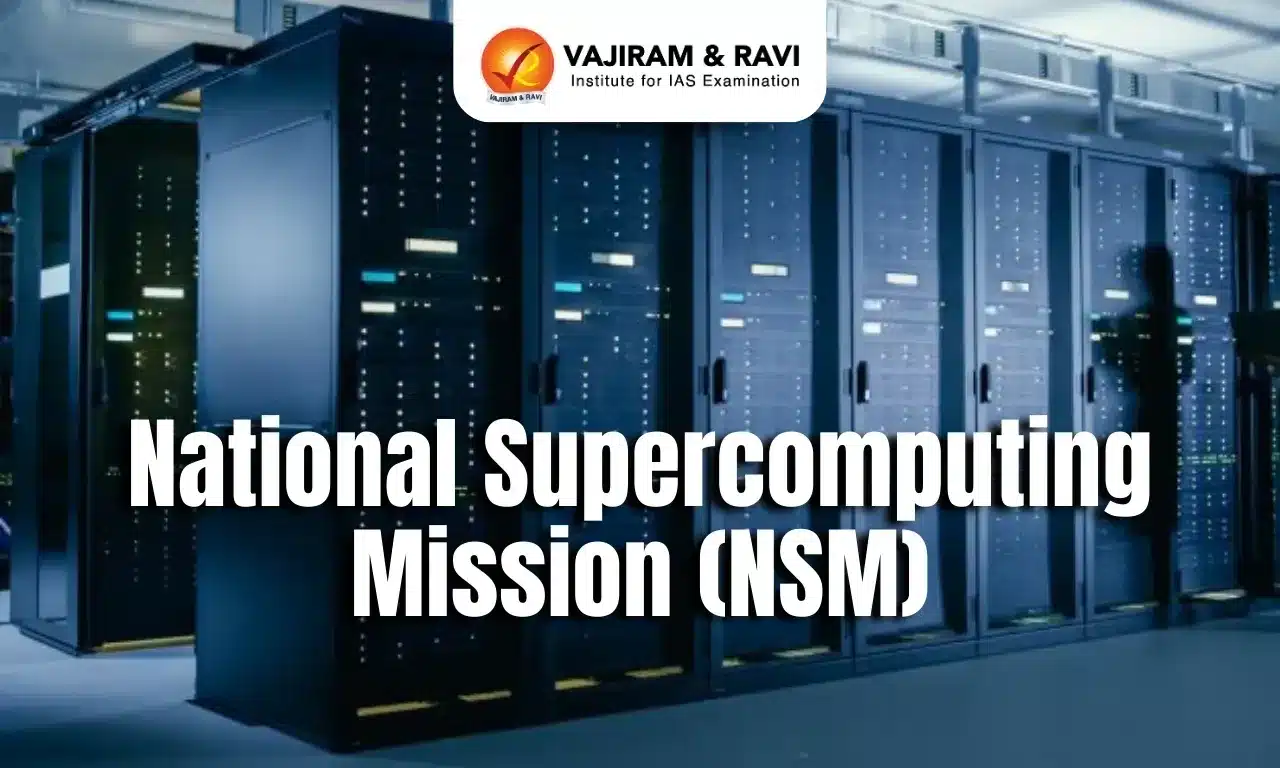National Supercomputing Mission (NSM) Latest News
National Supercomputing Mission: Powering India’s Future with Indigenous High-Performance Computing.
About National Supercomputing Mission (NSM)
- The National Supercomputing Mission (NSM) is a flagship initiative launched in 2015 by the Government of India to strengthen the nation’s High-Performance Computing (HPC) capabilities.
- It aims to enhance India’s computational capacity in sectors like science, technology, academia, research, and industry, making the country self-reliant in supercomputing technologies.
- The mission is jointly steered by the Department of Science and Technology (DST) and the Ministry of Electronics and IT (MeitY), and is implemented by C-DAC, Pune and IISc, Bengaluru.
- The key goal is to position India globally among top nations in supercomputing by enabling research, reducing technological import dependence, and creating a robust indigenous HPC ecosystem.
Indigenisation Milestones
- “Rudra” HPC servers, developed indigenously, are the first HPC-class servers built in India, matching global standards.
- Supercomputers like PARAM Rudra (Pune, Delhi, Kolkata) have been dedicated for advanced research in physics, cosmology, and earth sciences.
- The Trinetra high-speed network (developed under NSM) boosts data transfer rates up to 200 Gbps and is being rolled out in phases – PoC, Trinetra-A (100 Gbps), and Trinetra-B (200 Gbps).
AI Supercomputing: AIRAWAT
- The AIRAWAT project is India’s AI-focused supercomputing initiative under NSM, offering a common AI computing platform for start-ups, researchers, and innovation hubs.
- The Proof of Concept (PoC) system of AIRAWAT features 200 petaflops of AI processing power, scalable to 790 AI petaflops.
- AIRAWAT secured 75th rank in the Top 500 Global Supercomputing List (ISC 2023, Germany), placing India among the top AI supercomputing nations.
Institutional Milestones
- PARAM Shivay (2019) at IIT-BHU was the first indigenous supercomputer under NSM.
- PARAM Pravega (2022) at IISc Bengaluru is among the largest academic supercomputers in India, with 3.3 petaflops processing power.
National Supercomputing Mission (NSM) FAQs
Q1. What is the objective of the National Supercomputing Mission (NSM)?
Ans. The NSM aims to develop a high-performance computing (HPC) ecosystem in India, including indigenous supercomputers and advanced computing facilities.
Q2. Which two bodies jointly implement the NSM?
Ans. The NSM is jointly implemented by C-DAC (Centre for Development of Advanced Computing) and IISc Bengaluru (Indian Institute of Science).
Q3. When was the National Supercomputing Mission launched?
Ans. The NSM was launched in 2015.
Source: PIB
Last updated on December, 2025
→ Check out the latest UPSC Syllabus 2026 here.
→ Join Vajiram & Ravi’s Interview Guidance Programme for expert help to crack your final UPSC stage.
→ UPSC Mains Result 2025 is now out.
→ UPSC Notification 2026 is scheduled to be released on January 14, 2026.
→ UPSC Calendar 2026 is released on 15th May, 2025.
→ The UPSC Vacancy 2025 were released 1129, out of which 979 were for UPSC CSE and remaining 150 are for UPSC IFoS.
→ UPSC Prelims 2026 will be conducted on 24th May, 2026 & UPSC Mains 2026 will be conducted on 21st August 2026.
→ The UPSC Selection Process is of 3 stages-Prelims, Mains and Interview.
→ UPSC Result 2024 is released with latest UPSC Marksheet 2024. Check Now!
→ UPSC Prelims Result 2025 is out now for the CSE held on 25 May 2025.
→ UPSC Toppers List 2024 is released now. Shakti Dubey is UPSC AIR 1 2024 Topper.
→ UPSC Prelims Question Paper 2025 and Unofficial Prelims Answer Key 2025 are available now.
→ UPSC Mains Question Paper 2025 is out for Essay, GS 1, 2, 3 & GS 4.
→ UPSC Mains Indian Language Question Paper 2025 is now out.
→ UPSC Mains Optional Question Paper 2025 is now out.
→ Also check Best IAS Coaching in Delhi
Tags: National Supercomputing Mission (NSM) prelims pointers upsc prelims current affairs

















